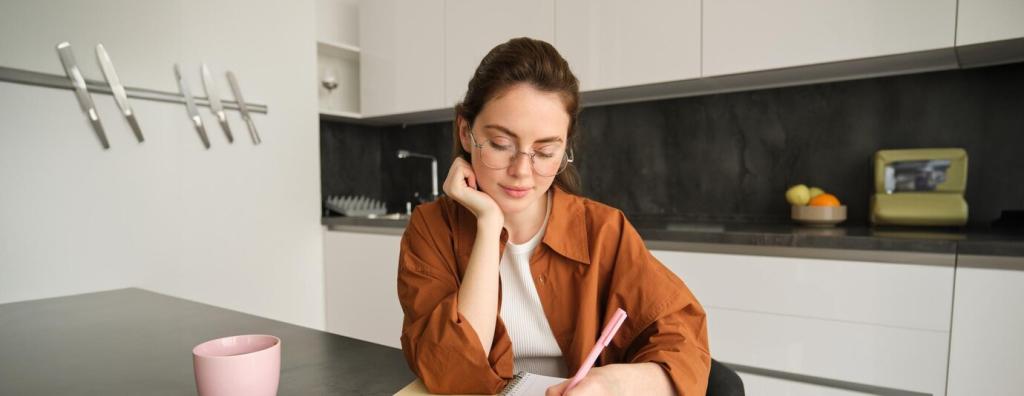Progressive Muscle Relaxation: Release Tension, Reclaim Calm
Progressive Muscle Relaxation is a structured sequence of brief, gentle tensing followed by longer, mindful releasing of muscles. By contrasting tightness and softness, your nervous system learns to downshift. Many people report calmer breathing, steadier focus, and fewer stress-triggered headaches after consistent practice.
What Progressive Muscle Relaxation Is
Beginner-Friendly PMR: A Step-by-Step Guide
Choose a quiet spot, silence notifications, and sit or lie comfortably with your spine supported. Loosen tight clothing and remove distracting accessories. Dim lights if possible. Set a timer for ten minutes. Before starting, take three slow breaths, lengthening your exhale to signal safety to your body.


Beginner-Friendly PMR: A Step-by-Step Guide
Working from feet to face, gently tense one muscle group for five seconds—never to pain—then let go for twenty to thirty seconds. Notice warmth, heaviness, or tingling. Allow gravity to do more of the work. If you feel strain, lighten the tension and prioritize softness over force.
Progressive Muscle Relaxation for Sleep
Thirty minutes before bed, dim lights, reduce screens, and play a soft PMR audio. Practice in bed or beside it, finishing with slow breathing. Consistency trains your nervous system to associate the sequence with sleep. Track your sleep and share results with our community for encouragement.
Progressive Muscle Relaxation for Sleep
Rather than fighting intrusive thoughts, bring attention to physical sensations. Tense, release, and label what you feel: warmth, heaviness, ease. That embodied focus reduces cognitive rumination. Many insomniacs report fewer nighttime awakenings after two weeks of nightly PMR paired with calm, extended exhales.
Progressive Muscle Relaxation for Sleep
Maya used to scroll at 2 a.m., wide awake. She tried a ten-minute PMR track nightly. Within days, her jaw unclenched faster, and her shoulders softened. Two weeks later, she fell asleep before the track ended. Tell us your first week’s highlight, no matter how small.

Desk-Friendly Mini Releases
Sit tall, place feet flat, and gently tense hands into fists for five seconds. Release and notice the contrast. Shrug shoulders lightly, then let them drop. Soften your jaw and tongue. In under two minutes, you create space between urgency and action, improving clarity before your next task.

Before Presentations or Exams
Anxiety often tightens forearms, shoulders, and the gut. Do a fast cycle: hands, shoulders, belly. Breathe in for four, out for six. Visualize success. That sequence lowers arousal without dulling alertness, helping you speak steadily, recall key points, and handle tough questions with grounded confidence.

Balance Activation with Release
Athletes thrive on precise nervous system tuning. Use PMR after skill work to reset baseline tension. Noticing subtle differences between tight and relaxed improves coordination and economy of movement. Many runners report smoother strides when they practice PMR on rest days alongside mobility and hydration.
Cooldown with Intention
After your session, lie down and scan from feet to face, pairing each release with a slow exhale. This intentional cooldown may reduce perceived fatigue and support better sleep, both crucial for adaptation. Keep notes in a training journal, and update our thread with your weekly observations.
Modify When Sore or Injured
Avoid tensing areas that are acutely painful or inflamed. Instead, imagine them softening while you gently work surrounding muscles. Consult your clinician if unsure. Comfort first, always. Share your modifications so others with similar limitations can practice safely and continue building relaxation skills.
Pairing PMR with Breath and Imagery
Diaphragmatic Breathing as a Foundation
Place a hand on your belly and inhale so it gently rises; exhale longer than you inhale. Layer PMR on top of this rhythm, syncing releases with the out-breath. The vagus-nerve-friendly pattern can amplify calm and help the body anchor new relaxation habits more quickly.
Body Scan Meets PMR
Before tensing, scan each region and rate its tension from one to ten. After releasing, rate again. The numbers help your brain register progress, reinforcing learning. Over time, many areas need less tensioning to relax. Post your before-and-after ratings for a week to track change.
Guided Imagery to Soften Muscles
While releasing, picture heavy sand gently pouring out of your limbs or warm sunlight loosening fibers. Imagery engages attention and emotion, boosting relaxation depth. If one image resonates, reuse it as a signature cue. Invite readers to share their favorite calming images for a community library.
Note time of day, duration, and any changes in mood, sleep, or muscle comfort. Quick reflections help you spot patterns that motivate consistency. If mornings feel best, protect that slot. Share your template with our readers so newcomers can start tracking without overthinking the details.
Build a Lasting Progressive Muscle Relaxation Habit
If you forget, pair PMR with an existing habit, like brushing teeth. If you get bored, rotate scripts or add music. If tension spikes, reduce intensity and shorten holds. Progress is non-linear; celebrate small wins. Comment with one obstacle you faced and the tweak that helped.
